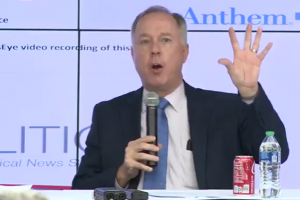
The city of Gainesville, Florida, needed to choose a site for a dump. Of all the places it could have chosen during its search in the late 1950s, the local government settled on an unlikely location: the backyard of a school. Joseph Williams Elementary sat on the east side, in the predominantly Black part of town.
Where children played, the ground bubbled. Birds swarmed, feeding on trash. At one point, a pile of 20 dead dogs and cats were dropped in the yard of the elementary school, just 100 feet away from classrooms. This was no ordinary playground.
A horrific stench of dead rats and decomposing garbage was impossible to escape, recalled Wayne Fields, who still lives in his childhood home opposite the site. “The smell was so bad, during school, after school,” said Fields, a 69-year-old businessman. “It was ridiculous.”
Both of Fields’s parents were teachers at the school. “We used to say that when we turn off the light we can all see each other because we are glowing from the chemicals,” he said.
Despite violating multiple health statutes, the local government was unbothered. “This is a necessary evil. I think we’re doing a very fine job,” then-City Manager William Green said in 1963. Besides, he said, the city poured “glorified perfume” on the garbage every so often.
This “necessary evil” has haunted this Florida community for decades. Sixty years later, the site is overgrown grassland, but contamination at the school still poses a large risk to students’ health. In the last few years, community members have called on the Alachua County school district and state agencies to assess the connection between the contaminated land and health issues in the area.
It is often difficult to show a direct link between a contaminant and adverse health impacts, and no such investigation has yet been done at the school. But for years soil and air testing have consistently revealed evidence of substantial environmental toxins on the property. Levels of the carcinogen benzo(a)pyrene peaked in 2020 at a concentration up to 218 times higher than what is considered safe for direct exposure in residential settings. Researchers, meanwhile, have pinpointed East Gainesville as an asthma hot spot.
For decades, a rotating cast of city, county, and state officials have been aware of the contaminants in the school yard — and have taken little action to address the problem, The Intercept found in an investigation based on hundreds of public and archival documents, government emails obtained through records requests, and interviews with dozens of Gainesville residents.
Alachua County officials have proposed renovations to the school and overseen the removal of some contaminated soil from the property in the last decade, while a local nurse’s advocacy prompted the state health and environmental protection departments to order additional soil testing in recent years. Their primary focus has not been the former landfill but another contaminant discovered decades ago: abandoned oil tanks. Yet what’s needed, former school district employees and community members say, is nothing short of the removal of the school in its entirety, a full cleanup of the site itself, and a comprehensive assessment of the impact of soil toxins on students’ health. Neither the school district nor the Florida Department of Environmental Protection seem willing to go that far.
“Williams Elementary is safe,” said Jackie Johnson, a spokesperson for Alachua County Public Schools, in an email to The Intercept. She added that the school board hasn’t received a formal recommendation to demolish or majorly reconstruct the school and that the district has no current plans to do so.
District representatives met with the Department of Environmental Protection in January, Johnson said, and “it was made clear that there is currently no health threat to students or staff at the school.”
But just last month, the school board and the environmental protection department approved another round of soil and air testing at Williams.
The state Department of Health “has responded to many community concerns regarding Williams Elementary School,” Paul D. Myers, the department’s administrator in Alachua County, told The Intercept in an email. The state environmental protection department “continues to monitor the successful remediation at Williams Elementary” and will keep working with the school district and city “on any contaminated or potentially contaminated properties,” wrote Kathryn Craver, an external affairs director at the department’s northeast district.
An Intercept investigation reveals:
- The city of Gainesville, Florida, placed a landfill in the backyard of Joseph Williams Elementary School in the 1950s. The dump was closed 60 years ago, but even after other environmental issues were discovered on the site, it was never fully cleaned up.
- Years of soil and air testing have revealed substantial evidence of environmental toxins on the property, which sits in a chronically underfunded and predominately Black part of town. In 2020, the level of one carcinogen detected at the site peaked at up to 218 times higher than what’s considered safe in residential areas.
- The Alachua County School District has cleaned up some soil from the property. But neither the county nor the state has agreed to fully clean up the site or conduct a comprehensive study of the toxins’ impact on students’ health.
This situation in Gainesville is not an anomaly. Dozens of schools across 35 states sit on or adjacent to former, or currently open, landfills, according to The Intercept’s analysis of news articles, state databases, and public records from across the country. From New York to Ohio, there have been many reported cases of illness, predominantly cancer, from both teachers and students who have attended schools next to hazardous waste. These occurrences tend to be in lower-income communities of color, The Intercept found.
No federal agency prohibits new schools being placed on, or next to, dump sites, or requires schools near landfills to conduct cleanups. In 2011, the Environmental Protection Agency was authorized by Congress to create voluntary school siting guidelines, but these remain discretionary and don’t apply to existing schools.
Florida state law makes it illegal to build a new K-12 school on or adjacent to a known contaminated site unless steps are taken to ensure that children will not be exposed to threatening levels of contaminants. But at Williams Elementary, like other schools in Florida, the contamination surfaced years after it was built.
“It’s this long-standing pattern of the devaluing of people of color, pushing them into less desirable spaces.”
The lack of regulation to address decades-old problems deepens an enduring crisis of environmental racism.
“We see a really strong pattern where white affluent students are facing significantly less risk at school,” said Sara Grineski, a sociology professor at the University of Utah who studies environmental health disparities. “It’s this long-standing pattern of the devaluing of people of color, pushing them into less desirable spaces.”

Second-Class Citizens
Williams Elementary is named after the Black businessman who built it in the 1930s, seeing a need for a school on the east side of Gainesville. A middle school was built across the field in 1955 — a few years before the landfill was placed in the backyard of Williams.
“We were Black and seen as second-class citizens,” said Gussy Butler, aged 95, one of East Gainesville’s oldest residents. “They weren’t concerned; it was a Black area.”
The dump site was 150 feet away from students sitting in classrooms, and the pollution was made worse by the area’s impractical geography. The east side of Gainesville is lower and has more sensitive wetlands than the west, where economic development has generally been focused.
Local media began covering the dire consequences several years after the landfill was built. “The ditch is filled with black, stagnant water pumped from holes dug to hold the garbage,” the Gainesville Sun reported in June 1963. “The area being filled with garbage is wetter than normal so the odor problems are compounded. The health department conceded that the area is ‘a little too wet for an ideal landfill.’”
Still, the city stood firm. “Many of us and our children have spent many happy hours on top of a landfill,” wrote City-County Health Officer Edward G. Byrne in an op-ed at the time. “I do not believe this will be a major problem for Alachua County for some time to come.”
Yet by the end of that summer, following petitions to the city for relief, the dump was moved to airport land. It was already clear that the implications would be long-lasting. “Building on the filled land is out of the question for 10 to 15 years. As the garbage slowly decays the earth will gradually settle,” a Gainesville Sun article said. “Any building constructed on it probably would be ruined within a short period by the sinking.”
At the end of the decade, the Nixon administration founded the EPA, a pivotal moment in the monitoring of toxic sites. “Some of the reasons we have these situations occurring today is that prior to the foundation of the EPA, there were few, if any, environmental laws that protected human health,” said Claudia Persico, a professor at American University who researches environmental policy.
Yet, the EPA’s process for identifying so-called Superfund sites — referring to polluted and hazardous locations — has often failed to capture the most deprived communities. The EPA’s national priorities list is “a little bit ad hoc,” said Steph Tai, an environmental law professor at the University of Wisconsin–Madison. “It’s sort of advocacy based, like people have to advocate for something to rise to that level.”
In a chronically underfunded area such as East Gainesville, the landfill’s potential for long-term contamination was quickly forgotten after it was closed. With a lack of resources, people had other concerns. “It just went away,” Fields, who lives across the site, said. “Nobody discussed it.”

Sinking Buildings
At Williams Elementary, the prediction that buildings would sink proved prophetic, even a quarter of a century later. In 1989, the district began constructing a half-million-dollar music and art suite at the school.
“They put Williams at the top of the list because it had been deprived for so long,” said Jennifer Lindquist, a former art teacher at the school for 22 years.
Almost as soon as the new facilities were built, the building began to fall apart. “The crack became straight through the building and through the foundation and everything,” Lindquist said. “It was not sound ground. When they pulled up the borings you could still see decomposing trash.”
In April of that year, city planners — members of a citizen board that reviews land use — found records of the landfill while working on a report. Gainesville city commissioners told the Alachua County School Board to take soil samples. The school board was going to “run a plug down there and test the soil,” Norm Bowman, then planning board clerk, said at the time. “It’s no big deal.”
But the problems extended beyond the remnants of the former landfill. Around the same time, the Florida Department of Environmental Protection found “excessively contaminated soil” on the property that was polluting the groundwater. The contamination was attributed to four underground storage tanks containing heating oil. From the 1960s to 1980s, these were common in rural locations without main gas lines. The school board registered the tanks in 1987 but didn’t know when they had been installed, Craver, from the Florida Department of Environmental Protection, told The Intercept in an email.
In 1988, the school district applied for the environmental department’s Early Detection Incentive, which provided state-contracted cleanup to owners of underground petroleum tanks with suspected contamination. The site was assigned a ranking score of 9 out of 10. According to the department, “the higher the score, the greater the potential threat.”
But state officials ultimately decided that excavating the soil was “considered to be inappropriate … because of the high cost due to the depth of contamination.”
There are multiple conflicting narratives on the dates the tanks were removed. State records reviewed by The Intercept state that, as of 1991, three of the four tanks had been abandoned in place. Craver, meanwhile, said that three tanks were removed in 1988, with the other in 1991, but “oil can remain in soil for decades until remediated.”
What’s undisputed is that the tanks had corroded, leaving oil to seep out across the site. Still, the state went quiet for another two decades. This time, both the landfill and the oil tanks were forgotten.

Asthma Hot Spot
DeVante Moody, who started attending Williams in the late 1990s, remembers being teased about his “trash school.” At first he thought it was just typical school rivalry, or because the students sucked at sports.
“The running joke came from the community: ‘Oh, y’all go to the trash school,’” said Moody, now 31 years old and a support technician at the University of Florida hospital network. Like Wayne Fields, whose son also attended Williams, multiple generations of Moody’s family attended the school. His 11-year-old son now attends the neighboring Lincoln Middle School.
Moody recalls “the forbidden area,” a closed-off field the size of a large swimming pool, where students were not allowed to venture. They were never told why. Classrooms sat in trailers beside it, and children ran around the adjacent field at lunchtime.
It wasn’t until years later that Moody discovered it had been a landfill. “They literally meant ‘Y’all go to the trash school’ because it used to be a trash dump,” Moody realized. “So this is not a joke. This is serious.”
Throughout his childhood, Moody, like many of his classmates, had trouble breathing. “We were all just asthmatic children. We just thought it was normal,” he said.
Moody’s respiratory issues were particularly serious, and he was hospitalized twice with collapsed lungs. He distinctly remembers being in the intensive care unit at age 7, turning to his father and asking: “Am I going to die?”
Researchers recently identified East Gainesville as a pediatric asthma hot spot and linked poor health outcomes to racial and economic segregation. Across Alachua County, asthma-related hospitalization rates were nearly three times higher and emergency department visits were six times higher for Black residents than for white residents in 2018. Other research has shown that the hospitalization rate due to pediatric asthma in Williams Elementary’s ZIP code ranks among the worst 25 percent of ZIP codes in the state. The group most deeply affected are Black children aged 5 to 9.
It’s part of a nationwide trend: A study published by The Associated Press last year found that Black children are more likely to have asthma than kids of any other race in America, mostly due to the influence of past racist housing laws and proximity to pollution.
In 2008, a few years after Moody left Williams Elementary, the Florida Department of Environmental Protection mobilized contractors to test contamination at schools across the county. “The state asked us to quickly go run out to all multiple schools and take soil samples around just to try and make sure that everything’s OK,” said Jesse Brown, senior engineer at Golder Associates, who visited Williams and 20 other schools at the time. “They just wanted a quick snapshot to see what risk each of these sites had.”
At Williams, Brown’s team identified two of the former underground petroleum tanks and took half a dozen soil samples. They didn’t find anything concerning, according to a report the firm submitted to the state environmental agency.
Yet that finding did not appear to sufficiently assuage the agency. Seven years later, the agency reached back out to the Alachua County School Board about Williams Elementary to offer more state funding for research into petroleum contamination. Another contractor was sent out to the school in 2015. Over the next two years, engineers who analyzed soil samples found high concentrations of multiple carcinogenic chemicals and benzo(a)pyrene equivalents, a way of evaluating the overall carcinogenicity of multiple compounds. BaP — which is commonly found in cigarette smoke, exhaust fumes, and asphalt — and BaP equivalents are generally considered safe at concentrations of 0.1 mg/kg. At Williams, analysts detected a level of 7.2 mg/kg. Prolonged exposure to the chemical increases the risk of cancer, as well as asthma, according to scientific studies.
In general, communities of color suffer disproportionately from environmental toxins. Grineski, the University of Utah sociology professor, said that her research shows that “a district with more foreign born kids and more Black kids has greater concentrations of cancer-causing air toxins than other school districts.”
The state’s health department, which investigates cancer clusters, does not consider East Gainesville to have a higher than normal incidence of cancer. The agency “does not have any data that is indicative of a cancer cluster in the community,” Myers, the department’s administrator in Alachua County, told The Intercept in an email.
Still, Fields, who struggles with various health issues — including trouble breathing since he had a heart attack a couple years ago — strongly believes it to be so.
On a drive around East Gainesville, Fields gave a biography of the generations of homeowners. As he pointed out house after house, he explained how each family had in some way been affected by the disease.
“This neighborhood is mostly made up of widows,” he said.

A Community’s Outrage
In 2017, two years after the state funded a new round of testing at Williams Elementary, the Alachua County school district issued a press release notifying parents that elevated levels of BaP had been found in the soil, due to contamination from petroleum products.
The district said it would be removing and replacing soil from parts of the school courtyard. Still, school officials assured parents that “the levels found at Williams would not pose a health risk unless there is a lifetime of exposure, which would mean eating or touching the soil every day for thirty years.”
For Moody and Fields’s families, who had lived in East Gainesville all their lives, being in such close proximity daily is not that much of a reach. Yet, Moody, whose cousins attended Williams that year, said that, to his knowledge, his relatives didn’t hear about the contamination at the time. “My family had not one clue,” he said.
The state removed over 2,500 tons of petroleum-contaminated soil from the courtyard and transported it to a waste site in Georgia before the start of the school year in September. A concrete cap was placed over the remaining contaminated soil until it could be excavated in school breaks over the following year. Another 1,000 tons were removed between December 2017 and June 2018.
“Due to this excavation and removal, the accessible soils are no longer an exposure risk,” Craver said.
Meanwhile, the school district held a public forum, titled “Schools of the Future,” where community members could submit anonymous feedback. Many of the comments mentioned the Williams and Lincoln schools — and some referenced the former dump site. “Can Williams Elementary use the surrounding land to increase/renovate since the school was built on a dump site!! This should be a priority!!!” one comment said. “Remove Lincoln and Williams off the dump site,” another person wrote.
With no further action from local officials, community members continued to press the issue. In June 2019, Fields and other residents expressed their frustrations on the area’s history in a public county meeting on plans to expand another dump site in the area.
“What you’re talking about doing, it’s preposterous,” Fields said.
As Covid-19 hit, others started asking questions. Alexandria Owens, a pediatric critical-care nurse scientist working in East Gainesville, began to look into why so many kids ended up in the intensive care unit with asthma issues.
Poking around online, Owens found the state records about the eroded oil tanks at Williams. She spent hundreds of hours reading documents and compiling data. She wondered if there was a correlation between the toxic soil and the state of children’s health in the area. “Kids end up on life support,” Owens said. “It’s alarming knowing that these types of chemicals can exacerbate asthma.”
Owens had no idea about the former dump site, which is not mentioned in state environmental or health department records. But she started reaching out to the school district in March 2020 about the high asthma rates in the neighborhood and the leaked oil tanks. “I felt like my argument was even stronger because these kids are at a higher risk, let’s actually sound the alarm because Covid-19 is happening,” Owens said. “But that did not happen.”

At every turn, Owens was being stalled. “You don’t need to be calling all these people,” a manager of the Petroleum Restoration Program at the Florida Department of Environmental Protection told her in a phone call in June 2020, according to notes Owens took at the time. “Pediatric asthma wasn’t in our top priority list,” a community programs administrator at the Alachua County Health Department told Owens the following month. (The employee was referencing priorities from a county-level assessment that happens every few years, according to Myers, the health department’s administrator in Alachua County.)
It was Owen’s outreach that ultimately triggered the Florida Department of Health to conduct an assessment at the school. In July 2020, the department published a report stating that it “does not expect the occurrence of health risks associated with exposure to groundwater and soil.” But the report was not comprehensive; the department could not evaluate indoor air quality or assess the impact on students prior to 2016 due to insufficient or unavailable data.
The department said the concentrations of BaP that had previously been found in the soil could create additional health risks if it vaporized into the air. The report recommended that the department continue to assess indoor and outdoor air quality for the presence of the chemical. Owens was relieved an assessment had been done but continued to press state and local officials on the issue.
At times, she grew frustrated with the process. In a July 2021 email outlining an apparent miscommunication between the school district and the state environmental agency about the state’s plans for the school, she wrote that such communication breakdowns “will continue to delay the timely remediation of a problem that could absolutely exacerbate health issues in the children from my community.”
She also felt that, in addition to testing, there needed to be more excavation — and that the school building should be moved.
To help reach residents of Gainesville impacted by the pollution exposed in this article, The Intercept is sending postcards to the local community about the potential exposure to toxic chemicals at their neighborhood school. Our mailer will share key findings from the story and information about the governmental agency that can address the problem, along with a chance to speak with our team.
Stalled Reconstruction
Carlee Simon, who became interim superintendent of Alachua County Public Schools in December 2020, shared Owens’s assessment. Simon had attended Williams as a child, and her parents were teachers in the district, but she knew nothing of the site’s toxicity before starting the job.
Based on the information she got from colleagues and the environmental department and the aged state of the building, Simon soon concluded that the only solution was to rebuild the entire school. “We needed to have the entire building demolished,” Simon said. “Our discussions were how long would it take between us tearing down the building and the soil actually being addressed and ready for us to build on. That was like a massive unknown.”
It was likely going to take years, and the school board was divided. “It was pretty clear that budget priorities of the past shaped that community,” she said. She noted that a new school was built in a wealthier part of Gainesville just a few years earlier. “The first completed school they built was in a highly affluent and influential community, not a dilapidated building on the east side,” she said.
Gainesville’s east side is also still haunted by the decision back in the 1950s to put a dump in a residential neighborhood near two schools. Archival records show that city officials placed the landfill near the schools with the hopes that burying trash in the swampy land would make the land usable in the future. Jennifer Smart, the communications director for the city of Gainesville, told The Intercept the current government couldn’t speak to the school’s environmental problems. “With so much of this timeline reaching back many decades, it’s a historical record in which current City of Gainesville leadership did not participate and have no specific knowledge,” Smart wrote in an email.
Experts told the Intercept that cost-pressed governments often build schools on cheap land. “The tension is often between like there’s concern for student’s health, but also there’s the concern about using public monies for more expensive lands,” said Tai, the UW–Madison environmental law professor. “So a lot of times economic concerns sort of pressure states into still siting schools in toxic areas.”
After multiple disagreements with the board, including on other topics such as how to handle Covid-19, Simon was fired from the job after 15 months — the seventh superintendent to leave the job in the last 10 years. She is now interim dean for the School of Education at the University of Alaska Southeast.
While internal school district emails indicate there were plans to renovate the school in 2021, that has still not happened. A list of reconstruction projects on the school district website dating back to November 2019 describes design plans for four other schools in the district. Williams Elementary, however, is stuck in limbo. According to the website, “the district is drafting the required state application for permission to demolish buildings on the campus.”
Johnson, the school district spokesperson, told The Intercept that the Covid-19 pandemic drastically changed the district’s reconstruction plans: “Facilities projects that have been completed have cost much more than originally expected, affecting the timeline for other proposed projects.” Williams is among the projects that fell by the wayside.

More Testing, More Toxins
Soil and air testing have been a constant at Williams Elementary over the last several years. Since July 2020, state contractors have been deployed to the school at least a dozen times.
The most alarming results came in November 2020, when soil testing revealed BaP equivalent levels of 21.8 mg/kg in one part of the property: 218 times over the recommended residential limit. (State records show that BaP equivalent levels fluctuated over the next year and a half, dropping down to 7.8 mg/kg in that same area by July 2022 and to 2.6 mg/kg on a different part of the property.)
In a letter to Williams Elementary in December 2020, the Florida Department of Environmental Protection alerted the school that two chemicals, naphthalene and acenaphthene, had been found in the soil. The latter was present at three times the standard level. Exposure to naphthalene by inhalation is associated with hemolytic anemia, damage to the liver, and neurological damage, according to the EPA. In late 2021, the environmental department installed a venting system underneath one of the school’s buildings to mitigate soil concentrations of naphthalene.
Air quality has also been a persistent issue at Williams, and on at least one occasion in 2020, a teacher reportedly complained about it to the principal, according to an email obtained by The Intercept. State contractors, meanwhile, have repeatedly found elevated levels of chemicals in the air at Williams, including chloroform, a possible carcinogen that is often used in industrial processes.
In February 2021, after Owens’s urging, the state Department of Health released a report sampling six indoor air and four outdoor locations at the elementary school. The department found that it was possible there would be vapor intrusion, which is the migration of chemicals from the soil into the air. The report found that some concentrations of chemicals, including benzene, carbon tetrachloride — which can produce kidney and liver damage — and chloroform were at a level where they could cause considerable health risk through exposure. The health department recommended continued air monitoring.
That same month, a firm contracted by the environmental department reported excess levels of naphthalene in the air, as well as BaP in the soil.
Despite the findings in Gainesville, the state health department touted Williams Elementary as one of its “Success Stories.” Though students and workers at the school had been “exposed to contaminated soil and air,” the post said, they were not expected to develop adverse health effects.
Experts studying air pollution in schools have revealed it has extremely damaging effects on children. “Air pollution can cause what’s called externalizing behaviors, aggressive behaviors in kids,” said Persico, the American University public policy professor. “That causes them to get into fights or to misbehave, and then they’re more likely to be suspended in school.”

An Ongoing Issue
Despite years of appeals from within the school and the broader community, Williams Elementary is still trying to find a way to get rid of the polluted soil. The school district’s maintenance manager asked the Florida Department of Environmental Protection in an email last May “about the possibility of having some assistance with the removal of the contaminated soil, if and when the Board decides to demo Buildings 1 and 2 at Williams.”
An environmental consultant at the department responded that the agency could investigate and cover the cost of needed remediation if the school board approved renovations or demolition.
The environmental department recently contracted Leah D. Stuchal, a research professor at the University of Florida, to review air testing results from November that revealed excessive levels of chloroform. In February, Stuchal concluded that the excess levels “were not believed to be a result of petroleum contamination” and that monitoring for petroleum contaminants in indoor air was no longer needed. Still, Stuchal recommended continued monitoring for chloroform, of which the source remains unclear.
“The recommendation for continued monitoring of chloroform is because the source is unknown and the population exposed involves children,” Stuchal told The Intercept in an email.
Craver, of the environmental department, said that “out of an abundance of caution,” the agency “continues to maintain a passive venting system and conduct indoor air monitoring.”
The school recently concluded another round of testing, but there are no public records of testing at Lincoln Middle School across the field. And the long-forgotten landfill remains part of the land’s history.
Meanwhile, community members in East Gainesville have been waging a fight against the expansion of a different landfill. Just 2 miles from the schools, it was meant to close in January but has applied to continue operating until 2028. As a local news outlet reported last year, “It’s history repeating.”
“The people in our neighborhoods … I can guarantee you they have experienced enough tragedies,” Fields said in a county meeting on the proposed landfill plans. “It used to be an ongoing joke in our neighborhood, we are all gonna die from cancer because the dump site was right there between Lincoln and Williams Elementary. Well, guess what happened?”
The reporting for this article was supported by the Fund for Investigative Journalism.










